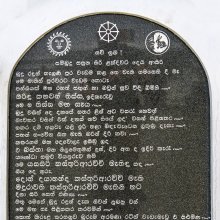Seya, Sheya: 6 definitions
Introduction:
Seya means something in Hinduism, Sanskrit, the history of ancient India. If you want to know the exact meaning, history, etymology or English translation of this term then check out the descriptions on this page. Add your comment or reference to a book if you want to contribute to this summary article.
Seya has 5 English definitions available.
Images (photo gallery)
Languages of India and abroad
Sanskrit dictionary
[Deutsch Wörterbuch]
Source: Cologne Digital Sanskrit Dictionaries: Böhtlingk and Roth Grosses Petersburger WörterbuchŚeya (शेय):—partic. fut. pass. von 2. śī [Pāṇini’s acht Bücher 7, 4, 22, Scholiast]
--- OR ---
Seya (सेय):—n. von sā = san in śata .
Sanskrit, also spelled संस्कृतम् (saṃskṛtam), is an ancient language of India commonly seen as the grandmother of the Indo-European language family (even English!). Closely allied with Prakrit and Pali, Sanskrit is more exhaustive in both grammar and terms and has the most extensive collection of literature in the world, greatly surpassing its sister-languages Greek and Latin.
See also (Relevant definitions)
Starts with (+15): Ceya, Ceya-nirkaruttan, Ceya-pattuvinai, Ceya-patu-porul-kunratavinai, Ceyaceti, Ceyacurai, Ceyai, Ceyakosham, Ceyal, Ceyalai, Ceyalali, Ceyalaravu, Ceyam, Ceyanir, Ceyankontan, Ceyantan, Ceyaparam, Ceyapari, Ceyapitam, Ceyar.
Ends with (+49): Adhyavaseya, Ahuaseya, Ahutasheya, Anarsheya, Anuseya, Apaurusheya, Arsheya, Atryarsheya, Aurvasheya, Aurvvasheya, Avaseya, Ceya, Chadisheya, Daisheya, Daksheya, Dasheya, Dhautakauhsheya, Dhautakausheya, Didriksheya, Dvyarsheya.
Full-text (+13): Sea, Varanaseya, Kalasheya, Avaseya, Seyya, Shataseya, Naikasheya, Anustarana, Varanasi, Ceyankontan, Iyam, Verri, Celika, Mahavalli, Ceyam, Ramani, Kausuma, Manavaka, Vaṇita, Stupa.
Relevant text
Search found 32 books and stories containing Seya, Sheya, Śeya, Sēya; (plurals include: Seyas, Sheyas, Śeyas, Sēyas). You can also click to the full overview containing English textual excerpts. Below are direct links for the most relevant articles:
Later Chola Temples (by S. R. Balasubrahmanyam)
Temples in Allur < [Chapter XII - Temples of Kulottunga III’s Time]
Appendix: Nanadesis < [Chapter XVI - Temples of Rajendra III’s Time]
Appendix: Temples or parts thereof built and miscellaneous facts < [Chapter II - Temples of Kulottunga I’s Time]
Sanskrit sources of Kerala history (by Suma Parappattoli)
2. Kerala-kshetra-mahatmyam < [Chapter 2 - Historical details from Mahatmyas and Prashastis]
Rig Veda (translation and commentary) (by H. H. Wilson)
Garga Samhita (English) (by Danavir Goswami)
Verse 5.17.15 < [Chapter 17 - The Gopis Describe Their Remembrance of Sri Krsna]
Bhakti-rasamrta-sindhu (by Śrīla Rūpa Gosvāmī)
Verse 1.1.36 < [Part 1 - Qualities of Pure Bhakti (bhagavad-bhakti-bheda)]
Verse 2.1.372 < [Part 1 - Ecstatic Excitants (vibhāva)]
Verse 1.3.24 < [Part 3 - Devotional Service in Ecstasy (bhāva-bhakti)]
The Tattvasangraha [with commentary] (by Ganganatha Jha)
Verse 1225 < [Chapter 17 - Examination of the Definition of Sense-perception]
